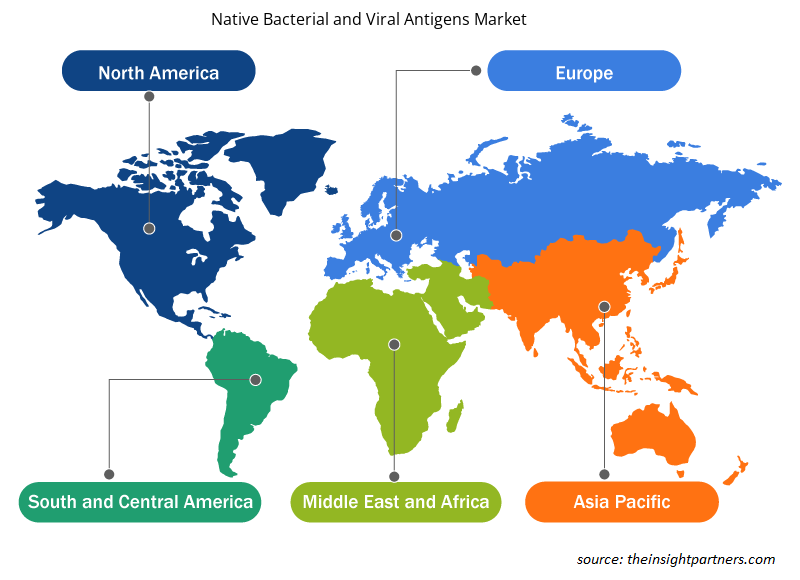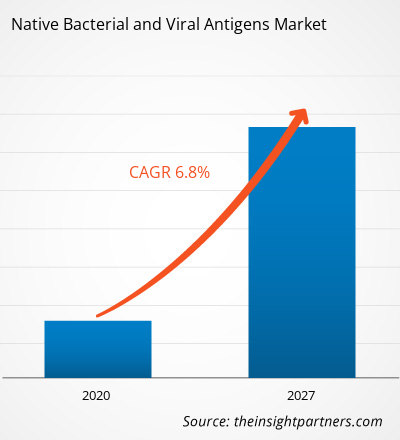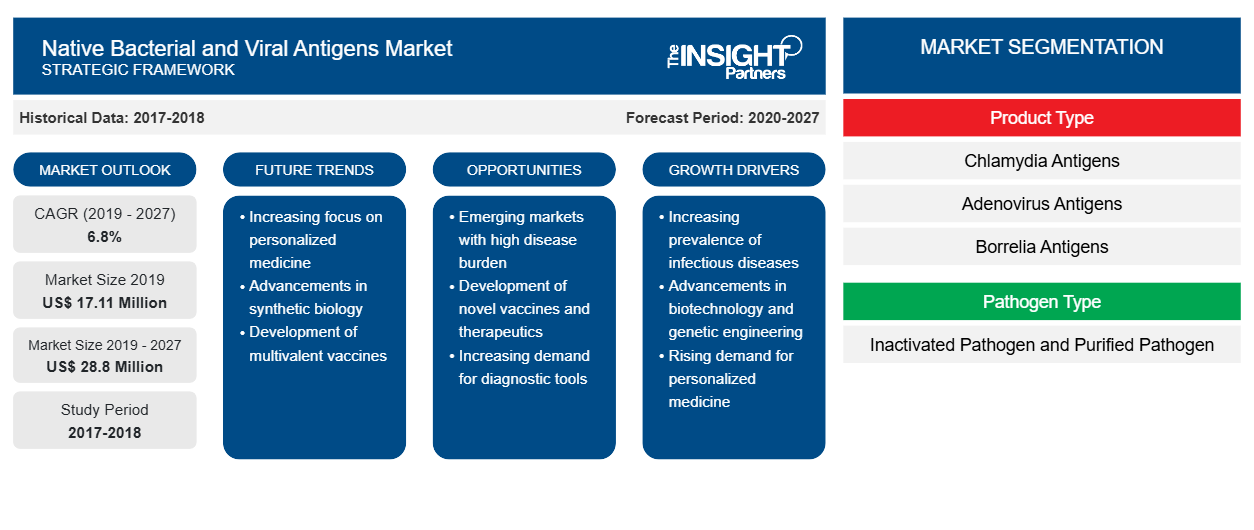Le marché des antigènes bactériens et viraux natifs devrait atteindre 28 801,15 milliers de dollars américains d'ici 2027, contre 17 105,05 milliers de dollars américains en 2019 ; il devrait croître à un TCAC de 6,8 % de 2020 à 2027.
Les antigènes natifs sont extraits sous leur forme naturelle à partir des sources respectives. Comme ils subissent des modifications habituelles in vivo, une fois isolés, ils présentent une ressemblance étroite avec la structure tridimensionnelle complexe qu'ils présentent dans l'hôte. Dans le cas des antigènes protéiques, ces modifications peuvent inclure des altérations post-traductionnelles telles que le clivage de protéines précurseurs, la formation de liaisons disulfures et l'ajout de groupes de faible poids moléculaire par des processus tels que la glycosylation ou la phosphorylation. Le marché mondial des antigènes bactériens et viraux natifs est déterminé par des facteurs tels que l'utilisation croissante d'antigènes microbiens natifs dans les diagnostics et les thérapies, et la prévalence croissante des maladies infectieuses. Cependant, les limitations associées aux antigènes natifs, telles que le coût élevé, les faibles niveaux de production d'antigènes et les difficultés de mise à l'échelle, entravent la croissance du marché. Cependant, les marchés émergents créent des opportunités de croissance pour les acteurs du marché.
Personnalisez ce rapport en fonction de vos besoins
Vous bénéficierez d'une personnalisation gratuite de n'importe quel rapport, y compris de certaines parties de ce rapport, d'une analyse au niveau des pays, d'un pack de données Excel, ainsi que de superbes offres et réductions pour les start-ups et les universités.
-
Obtenez les principales tendances clés du marché de ce rapport.Cet échantillon GRATUIT comprendra une analyse de données, allant des tendances du marché aux estimations et prévisions.
Informations sur le marché
Utilisation croissante des antigènes microbiens natifs dans les diagnostics et les thérapies
Les antigènes sont des biomolécules capables de déclencher une réponse immunitaire dans le corps hôte par l'activation des lymphocytes. Les antigènes bactériens sont utilisés dans le développement de divers types d'anticorps dans les laboratoires de recherche pour l'amélioration du système immunitaire. De plus, les antigènes bactériens sont également largement utilisés dans les tests d'immunodiagnostic tels que l'ELISA.
L'analyse des bibliothèques d'antigènes natifs a conduit au développement d'anticorps neutralisants puissants contre diverses infections bactériennes et virales. Les antigènes natifs sont extraits sous leur forme naturelle d'une source correspondante. Il existe une forte demande pour un grand nombre d'antigènes natifs, en particulier dans les diagnostics in vitro et la recherche sur les vaccins. Selon diverses études scientifiques, les antigènes recombinants présentent des problèmes de solubilité et d'agrégation. De plus, l'association d'antigènes recombinants avec des entités non protéiques est également différente et parfois insuffisante en termes de performances par rapport aux antigènes natifs.
Avec la récente épidémie de COVID-19, les entreprises développent des antigènes commerciaux du SRAS-CoV-2 pour soutenir la formulation du vaccin, ainsi que la recherche et le développement pour renforcer le diagnostic et le traitement de la maladie. En février 2020, la société Native Antigen est devenue la première entreprise à commercialiser les nouveaux antigènes du coronavirus, en utilisant le système d'expression exclusif VirtuE (HEK293) de la société. Ainsi, l'utilisation croissante d'antigènes natifs, qui soutiennent efficacement le diagnostic et la thérapie de diverses pathologies, stimule la croissance du marché des antigènes et anticorps bactériens natifs.
Informations basées sur le type de produit
Le marché des antigènes bactériens et viraux natifs, en fonction du type de produit, est segmenté en antigènes de chlamydia, antigènes d'adénovirus, antigènes de borrélia, antigènes de clostridium, antigènes du virus du chikungunya et antigènes du virus de la dengue. Le segment des antigènes de chlamydia détenait la plus grande part du marché en 2019, et le marché de ce dernier devrait croître au TCAC le plus élevé au cours de la période de prévision. La croissance du marché de ce segment est attribuée à la disponibilité facile de ces antigènes, la majorité des acteurs du marché proposant commercialement ces antigènes sous forme native. En outre, l'utilisation d'antigènes de chlamydia dans les instituts de recherche et les laboratoires pour le développement de vaccins et de tests de diagnostic in vitro (DIV) devrait encore propulser la croissance du marché de ce segment.
Informations basées sur le type de pathogène
En fonction du type d'agent pathogène, le marché des antigènes bactériens et viraux natifs est segmenté en agent pathogène inactivé et agent pathogène purifié. Le segment des agents pathogènes inactivés détenait une part plus importante du marché en 2019 et il devrait enregistrer un TCAC plus élevé au cours de la période de prévision.
Informations basées sur les applications
En fonction des applications, le marché des antigènes bactériens et viraux natifs est segmenté en tests ELISA, immuno-essais, SDS-PAGE, hémagglutination et agglutination. Le segment ELISA détenait la plus grande part du marché en 2019 et devrait enregistrer le TCAC le plus élevé au cours de la période 2020-2027.
Informations basées sur l'utilisateur final
En fonction de l'utilisateur final, le marché des antigènes bactériens et viraux natifs est segmenté en laboratoires et centres de diagnostic et en instituts universitaires et de recherche. Le segment des laboratoires et centres de diagnostic détenait la plus grande part du marché en 2019 et devrait enregistrer le TCAC le plus élevé de 2020 à 2027.
Les lancements et les approbations de produits sont des stratégies couramment adoptées par les entreprises pour étendre leur présence mondiale et leurs portefeuilles de produits. Ces stratégies les aident à répondre à la demande croissante des consommateurs. La collaboration est l'une des principales stratégies adoptées par les entreprises opérant sur le marché des antigènes bactériens et viraux natifs pour élargir leur clientèle dans le monde entier, ce qui leur permet également de maintenir leur nom de marque à l'échelle mondiale.
Aperçu régional du marché des antigènes bactériens et viraux natifs
Les tendances et facteurs régionaux influençant le marché des antigènes bactériens et viraux natifs tout au long de la période de prévision ont été expliqués en détail par les analystes d’Insight Partners. Cette section traite également des segments et de la géographie du marché des antigènes bactériens et viraux natifs en Amérique du Nord, en Europe, en Asie-Pacifique, au Moyen-Orient et en Afrique, ainsi qu’en Amérique du Sud et en Amérique centrale.

- Obtenez les données régionales spécifiques pour le marché des antigènes bactériens et viraux natifs
Portée du rapport sur le marché des antigènes bactériens et viraux natifs
| Attribut de rapport | Détails |
|---|---|
| Taille du marché en 2019 | 17,11 millions de dollars américains |
| Taille du marché d'ici 2027 | 28,8 millions de dollars américains |
| Taux de croissance annuel composé mondial (2019-2027) | 6,8% |
| Données historiques | 2017-2018 |
| Période de prévision | 2020-2027 |
| Segments couverts |
Par type de produit
|
| Régions et pays couverts |
Amérique du Nord
|
| Leaders du marché et profils d'entreprises clés |
|
Densité des acteurs du marché des antigènes bactériens et viraux natifs : comprendre son impact sur la dynamique commerciale
Le marché des antigènes bactériens et viraux natifs connaît une croissance rapide, tirée par la demande croissante des utilisateurs finaux en raison de facteurs tels que l'évolution des préférences des consommateurs, les avancées technologiques et une plus grande sensibilisation aux avantages du produit. À mesure que la demande augmente, les entreprises élargissent leurs offres, innovent pour répondre aux besoins des consommateurs et capitalisent sur les tendances émergentes, ce qui alimente davantage la croissance du marché.
La densité des acteurs du marché fait référence à la répartition des entreprises ou des sociétés opérant sur un marché ou un secteur particulier. Elle indique le nombre de concurrents (acteurs du marché) présents sur un marché donné par rapport à sa taille ou à sa valeur marchande totale.
Les principales entreprises opérant sur le marché des antigènes bactériens et viraux natifs sont :
- LABORATOIRES BIO-RAD INC.
- Microbix Biosystems
- SERION Immunologie
- Aalto Bio Reagents Ltd
- Enzo Sciences de la Vie Inc.
Avis de non-responsabilité : les sociétés répertoriées ci-dessus ne sont pas classées dans un ordre particulier.

- Obtenez un aperçu des principaux acteurs du marché des antigènes bactériens et viraux natifs
Marché des antigènes bactériens et viraux natifs – par type de produit
- Antigènes de la chlamydia
- Antigènes d'adénovirus
- Antigènes de Borrelia
- Antigènes du virus Chikungunya
- Antigènes de Clostridium
- Antigènes du virus de la dengue
Marché des antigènes bactériens et viraux natifs – par type de pathogène
- Agent pathogène inactivé
- Agent pathogène purifié
Marché des antigènes bactériens et viraux natifs – par application
- ELISA
- Immuno-essai
- SDS-PAGE
- Hémagglutination
- Test d'agglutination
Marché des antigènes bactériens et viraux natifs – par EndUser
- Laboratoires et centres de diagnostic
- Instituts universitaires et de recherche
Marché des antigènes bactériens et viraux natifs – par géographie
-
Amérique du Nord
- NOUS
- Canada
- Mexique
-
Europe
- France
- Allemagne
- Italie
- ROYAUME-UNI
- Espagne
- Reste de l'Europe
-
Asie-Pacifique (APAC)
- Chine
- Inde
- Corée du Sud
- Japon
- Australie
- Reste de l'Asie-Pacifique
-
Moyen-Orient et Afrique (MEA)
- Afrique du Sud
- Arabie Saoudite
- Émirats arabes unis
- Reste du Moyen-Orient et de l'Afrique
-
Amérique du Sud et Amérique centrale
- Brésil
- Argentine
- Reste de l'Amérique du Sud
Profils d'entreprise
- LABORATOIRES BIO-RAD INC.
- Microbix Biosystems
- SERION Immunologie
- Aalto Bio Reagents Ltd
- Enzo Sciences de la Vie Inc.
- Jena Bioscience GmbH
- LABORATOIRES ROSS SOUTHERN
- La société Native Antigen
- Diagnostic créatif
- TRINA BIOREACTIVES AG
- Analyse historique (2 ans), année de base, prévision (7 ans) avec TCAC
- Analyse PEST et SWOT
- Taille du marché Valeur / Volume - Mondial, Régional, Pays
- Industrie et paysage concurrentiel
- Ensemble de données Excel
Rapports récents
Témoignages
Raison d'acheter
- Prise de décision éclairée
- Compréhension de la dynamique du marché
- Analyse concurrentielle
- Connaissances clients
- Prévisions de marché
- Atténuation des risques
- Planification stratégique
- Justification des investissements
- Identification des marchés émergents
- Amélioration des stratégies marketing
- Amélioration de l'efficacité opérationnelle
- Alignement sur les tendances réglementaires























 Obtenez un échantillon gratuit pour - Marché des antigènes bactériens et viraux natifs
Obtenez un échantillon gratuit pour - Marché des antigènes bactériens et viraux natifs